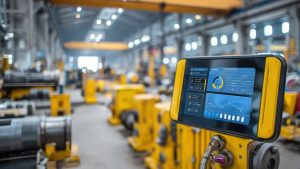In manufacturing, precision is paramount. AI-powered quality control is revolutionizing the industry. It offers a new standard for product excellence, catching minute flaws often missed by human eyes.
This transcends cost savings; it’s about fostering customer trust and loyalty. This blog post explores how AI is changing quality control in manufacturing.
We will examine the underlying technology, review real-world examples, and discuss what it means for production’s future.
Table of Contents:
- How AI is Changing Quality Control
- AI-Powered Quality Control: Real-World Examples
- Challenges and Opportunities
- What Does It All Mean?
- Conclusion
How AI is Changing Quality Control
Traditional quality control depended on human inspectors. However, people experience fatigue, and oversights occur. AI doesn’t have these limitations. AI operates continuously, evaluating each product with consistent precision, reducing the risks for inaccuracies and unreliability that can happen with manual quality assurance.
Spotting the Tiniest Flaws with Machine Vision
AI utilizes machine vision, essentially granting computers the ability to see. Cameras and sensors acquire images which are then analyzed by sophisticated algorithms. This identifies scratches, dents, and even subtle color variations imperceptible to the human eye.
This significantly increases accuracy. Manual inspection accuracy averages below 85%. AI algorithms tested on production lines have achieved 95% detection accuracy because AI processes substantially more data than humans.
Predicting Problems Before They Happen with AI Analytics
Consider AI as predictive maintenance for your factory. It anticipates potential issues by analyzing historical data and current conditions.
Perhaps a machine requires maintenance or a material batch is substandard. Early prediction enables proactive intervention, preventing minor issues from escalating.
Boosting Speed and Cutting Waste
In manufacturing, time equates to money. AI inspects items faster than humans, keeping pace with high-speed production lines. This accelerates processes and minimizes waste from defective products. For instance, rapid sorting and identification of flawed products by AI save valuable time, improving production processes and leading to superior products.
AI-Powered Quality Control: Real-World Examples
This is not a futuristic fantasy; it’s happening now. Companies experience substantial benefits using AI-driven quality control. For example, Audi uses AI to inspect car welds.
They discovered that AI reduced inspection labor costs by 30-50% and minimized rework. Each vehicle then undergoes manual inspection to guarantee flawless quality.
Case Study: Predictive Maintenance at a Bottling Plant
Consider a bottling plant. AI monitors motors and conveyors, detecting signs of wear. It alerts maintenance if something appears amiss.
This proactive approach provides significant savings, as even minor undetected problems can accrue substantial long-term costs, thereby lowering risks and strengthening cost control. With AI-powered visual inspection techniques, manufacturers can significantly reduce product defects leading to reduced waste.
Challenges and Opportunities
While impressive, AI quality control presents challenges. Obtaining sufficient training data can be difficult. Implementing the technology also involves financial investment. However, these obstacles diminish as technology improves and becomes more accessible.
There’s significant discussion surrounding Large Language Models (LLMs). While applications differ, it’s essential to acknowledge the long-standing history of this technology.
Quality professionals recognize that “artificial intelligence in quality control has already proven to be productive,” as discussed in this article by engineering.com.
What Does It All Mean?
AI-powered quality control isn’t just a trend. It’s likely the future of manufacturing. By embracing this technology, manufacturers improve product quality and safeguard their businesses’ future viability, improving defect detection accuracy by up to 99%, increasing yield rates and strengthening resource optimization.
Traditional quality assurance, reliant on labor and manual checks, has limitations and is unreliable. AI-powered systems are needed because of the advantages and financial returns associated with implementing them.
As this article highlights, using artificial intelligence in QA increases efficiency, precision, and cost-effectiveness. This allows businesses to meet industry quality standards. Implementing an AI-powered quality management system enhances accuracy for manufacturers.
AI rapidly analyzes vast real-time datasets, identifying patterns and anomalies for swift, informed decisions. Manufacturers mitigate downtime costs with AI-driven predictive maintenance. They use predictions for timely upkeep, ensuring continuous operation.
Additionally, the food and beverage sector utilizes AI in quality management for precision and real-time monitoring. This tracks products through production, verifying quality at each stage for end-to-end quality maintenance. Manufacturers, in order to boost operational efficiency and maintain a high quality threshold for products, benefit immensely from investing in AI technology that enhances production visibility and streamlines compliance protocols, strengthening productivity while increasing financial savings and improving their standing as a top industry performer.
Integrating AI quality assurance elevates product quality, increases productivity, and satisfies clients with timely deliveries, resulting in better process control and operational oversight. Ultimately, this strengthens competitive advantages and financial gains while ensuring sustainability.
Conclusion
AI-Powered Quality Control is not just a fashion; it represents a paradigm shift in manufacturing. By leveraging superior technologies, which include deep studying and device learning, producers can analyze substantial datasets in actual time, identifying patterns and anomalies with unheard-of precision. These technologies allow the introduction of strong mastering fashions, which continuously refine their abilities to conform to new demanding situations and manufacturing requirements. Industries, including medical devices and control systems, are already reaping the benefits of AI integration. In the medical sector, for example, AI visual inspection ensures that even the most minor flaws are detected in life-critical products, safeguarding patient safety and compliance with regulatory standards. Similarly, quality control systems optimized with AI contribute to higher product reliability and efficiency, streamlining quality control processes across various industries.
Incorporating AI into control structures complements operational oversight and efficiency by integrating with the delivery chain to offer quit-to-quit visibility. AI-pushed insights permit agencies to identify capability bottlenecks or defects in advance in the technique, ensuring nonstop improvement across all ranges of manufacturing. This fosters a lifestyle of excellence, assisting agencies to maintain competitive advantages in increasingly worrying markets.
AI-powered quality Control isn’t just about enhancing accuracy—it additionally strengthens control systems and permits seamless integration with current control structures, improving standard productiveness. As producers continue to adopt AI technology, they are poised to obtain advanced stages of precision, pace, and scalability in their operations. These improvements now not only increase consumer satisfaction through consistently first-rate merchandise but also pressure lengthy-term monetary sustainability.
By embedding AI into satisfactory management structures, companies can optimize their operations, mitigate risks, and create a sturdy framework for innovation. Integrating device learning and deep getting-to-know technology into high-quality manipulation procedures presents the foundation for smarter, more agile production. This guarantees that organizations are adequately prepared to navigate the complexities of present-day manufacturing, even as they exceed industry requirements and patron expectations.



